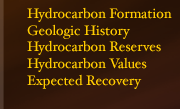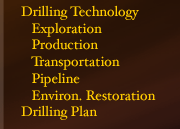
Exploration Technology
Seismic Exploration
Background
Seismic exploration uses vibrations such as sound waves and shock waves
in order to map the different layers of the ground, thus enabling the operator
to predict the earth's density at varying depths. It is able to map the subsurface
and to show in a 2-D, 3-D or even 4-D maps the explored region thus suggesting
the locations of the oil or gas "traps" for drilling purposes.
Seismic surveying uses tools such explosives or vibroseis trucks in order
to explore on land, or a tool called the airgun in order to explore offshore
(ocean floor).
Here is the explanation of seismic surveying by Utah BLM Stone Cabin:
"Seismic survey methodologies are tools for analysis of geologic
formations and features in the subsurface. The process consists of using a
source of energy that is directed into the subsurface and then recorded back
at the surface (with geophones) as the energy waves travel through the subsurface
and reflect back to the surface. Various types of rock reflect the energy
waves differently, and these differences are measured. Data helps show the
tops and bottoms of formations, thickness, and structural configurations.
It cannot identify pools of oil and gas, but rather, conditions favorable
for the possible accumulation of oil and gas."
This can be found at the link:
http://www.ut.blm.gov/stonecabin/Q&As.htm
Geophone by Gisco ( http://www.giscogeo.com/ )
Explosives
Seismic geophones are able to collect their data from
many sources that generate shock waves. Explosives method is one of those
sources. By drilling small holes into the ground, approx. 12 meters deep,
and packing them with 10 pounds of capped explosives (directed towards the
center of earth), followed by detonation of those explosives, the geophones
will be able to get sufficient data to map the are underneath the receivers.
The grid lines of the explosives vary because of the different ground composure.
Computer based software is often used to calculate the distance needed between
the location of such explosive holes. Based on the study assembled by USGS,
the grid of the explosives used in the seismic surveying that was done in
ANWR 1002, was about 300 feet between the charges. Geophones were positioned
in groups of 24 geophones per group while the interval between the groups
was about 100-160 feet. In overall there were 120 groups in use. Due to
the breaking of the ice immediately after detonation of the charges, the
geologists encountered many problems, such as picking up wrong vibration
data (vibration caused by the breaking and not by the blast) such secondary
data affected the precision of the survey.
"Thumper" trucks, Vibroseis
30,000 pounds trucks generate vibrations underneath the ground by
elevating themselves above the ground on a short pole, thus concentrating
their entire weight on a platter and "shaking" for several second per location,
thus sending vibrations through the ground.
The rest of the process is very similar to the explosive process because
all that is left is the data gathering phase. This process is the most precise
process as it uses controlled vibrations that are spread over period of
time, as oppose to the explosion vibration that is just a giant burst of
energy. Those trucks are able to operate even inside major cities because
the vibration they are causing is negligible due to the spread of vibration
over a period of time.
Airgun
Airgun is an excellent example of an offshore method.
This exploration technique is used with assistance from a ship that actually
carries all the equipment necessary to both send signal and to analyze.
Such ship will carry an airgun and many receivers at greater distance that
actually read the sound data as it is reflected from different rock formations
and layers beneath the ocean floor. Then, just as the land surveys, the
data is being processed by a computer which is later on able to generate
a detailed map of several layers underneath the sea bottom.
Data Processing
The data is being received by geophones, which
are relatively small devices placed on the ground. Those devices are synchronized
with computer and placed on the ground using DGPS equipment (more precise
than GPS, 2 meters to 30cm precision). This way the computer that analyzes
the data has all the variables, the time of the vibrations, the relative
distances at which the reflections are measured, and the strength (wavelength)
of the vibrations. Different rocks and layers give different reflections
of vibration, different changes in frequencies in the wavelength of the vibration.
Using this data, gathered from the sensors, the main computer unit is able
to constructed a detailed map, thus enabling it's user to analyze the map
for possible oil location. It is worth mentioning that the computer is in
most cases a dedicated super computer and not just a regular PC/MAC. The
computer is able to generate a 3-D map of the subsurface, enabling future
analysis of the region by experts and recommending a possible drill site.
Another capability is a generation of 4-D map, which is a relatively new
concept. Basically 4-D is a 3-D map repeated over time period. This way you
can also see any changes in the ground versus time. For example shift of
layers or flow of material in reservoirs.
The truck on the left is the vibroseis truck sending vibrations as waves
into the ground which are reflected of the different layer, recorder by
geophones and transmitted to the data recording truck
Non-Seismic Exploration Techniques:
Electrical Resistivity:
Overview: This process involves placing probes in the ground and passing
a current between them. By measuring the resistance of this current you are
able to tell within a degree of certainty whether there is oil or not.
www.digistar.mb.ca/minsci/ finding/resist1.htm
“Electrical and electromagnetic data are analyzed primarily to yield the
electrical resistivity of the rock formation where currents have been injected
or induced to flow. The resistivity is in turn a strong function of the porosity
and pore fluid saturation. (1)”
Potential Problems: The steel casing of the pipes underground can act as
a barrier to the electrical signals.
“Steel casing severely attenuates electromagnetic signals transmitted or
received from within the pipe. The casing typically acts as a low-pass filter,
attenuating signal above 10 Hz and virtually eliminating signals above a
few hundred Hz. …This means that field measurements are more difficult in
steel casing, and field data predominantly reflects casing effects. (1)”
Solutions: By taking into account the effects that the pipe has on the signal,
you can separate it when you interpret the data and just get the information
you want.
“Current research suggests, however, that the shielding effect of the steel
pipe is a fairly simple function of the thickness, electrical conductivity,
and magnetic permeability of the steel pipe segment surrounding the sensor.
Although EM fields are severely attenuated by the steel pipe, the response
may be calculated with fairly simple numerical models and separated from
the formation effect using straightforward techniques. …Thus, if the properties
are obtained, the response due to the casing may be easily separated from
the total field, leaving the formation response as a residual. (1)”
Experimental Methods
Earth’s field NMR:
By using the earth’s magnetic field, you can disrupt water molecules. By
measuring this disruption you can have a good idea of whether there is water
in an area. This technique is used for finding groundwater but it might be
able to be used to find oil as well.
“This technique involves locally perturbing the direction and amplitude of
the earth’s ambient magnetic field to affect the dipole moment of hydrogen-based
molecules (i.e. water or oil) within the pore structures. After the perturbing
field is shut off, a decay signal is generated in regions containing mobile
hydrogen atoms. These data can be used to estimate the porosity, saturation,
and possibly even permeability of these volumes. …Recently, a project has
been initiated through the DeepLook consortium to study the feasibility of
extending this technology to oil and gas exploration. (1)”
Electrical Vs. Seismic:
Electric is better at telling if there is oil and Seismic is better at telling
if there is gas. Seismic is also better at characterizing the structure of
the reservoir.
“Although electrical data are sensitive to variations in storage and saturation
of reservoir liquids, seismic techniques are more sensitive to the presence
of the reservoir gases. In addition, the higher resolution offered by seismic
techniques is superior in mapping reservoir structure. (1)”
Magnetic
Overview: By measuring the magnetic field, you can tell where there is likely
to be oil because the rocks that may contain oil have very low magnetic readings.
The magnetic field can be measured with an instrument called a magnetometer
which can be flown over an area or used on the ground.
“Magnetic surveys are usually made with magnetometers borne by aircraft flying
in parallel lines spaced two to four kilometers apart at an elevation of
about 500 meters when exploring for petroleum deposits. …Ground surveys are
conducted to follow up magnetic anomaly discoveries made from the air. Such
surveys may involve stations spaced only 50 meters apart. …Magnetic effects
result primarily from the magnetization induced in susceptible rocks by the
Earth's magnetic field. Most sedimentary rocks have very low susceptibility
and thus are nearly transparent to magnetism. Accordingly, in petroleum exploration
magnetics are used negatively: magnetic anomalies indicate the absence of
explorable sedimentary rocks. (2)”
Methods:
Proton-precession magnetometer: One type of magnetometer which utilizes the
disruption of protons in oil to measure magnetism. .
www.eri.u-tokyo.ac.jp/KOHO/ Yoran2001ep/08_05.html
“One such method involves the proton-precession magnetometer, which makes
use of the magnetic and gyroscopic properties of protons in a fluid such
as gasoline. In this method, the magnetic moments of protons are first aligned
by a strong magnetic field produced by an external coil. The magnetic field
is then turned off abruptly, and the protons try to align themselves with
the Earth's field. However, since the protons are spinning as well as magnetized,
they precess around the Earth's field with a frequency dependent on the magnitude
of the latter. The external coil senses a weak voltage induced by this gyration.
The period of gyration is determined electronically with sufficient accuracy
to yield a sensitivity between 0.1 and 1.0 nanotesla. (3)”
Schmidt vertical-field balance: Another type of magnetometer that measures
the relative magnetic field by observing the torque produced by the earth’s
magnetic field on the instrument. Using this instrument involves setting
up observation stations along the region of interest approximately a half
mile apart.
(www.xtrsystems.com/ magnetometer/coil)
“The Schmidt vertical-field balance, a relative magnetometer used in geophysical
exploration, uses a horizontally balanced bar magnet equipped with mirror
and knife edges. (4) “Field procedure consisted of observation stations located
at .5 mile intervals for reconnaissance surveys and .025 mile intervals for
detail surveys. (5)”
Evaluation: The field balance is a more accurate way of exploring for oil
when the region of interest is shallow.
“Field experiments showed that aerial magnetometers, proton precession magnetometers,
and gravity surveys were not sufficiently accurate to map the small topographic
lows of the Precambrian granite. Our conclusion was that only the field balance,
…could acquire the necessary data. (5)”
Gravitational
Overview: This procedure involves taking reading about a kilometer apart
throughout the region with a device called a gravimeter. The gravimeter measures
the gravitational field and this reading correlates with the density of the
region. By studying the differences in the density, you can predict which
areas of the region might contain oil
www.seismo.unr.edu/ftp/pub/ louie/class/492/album02/
“Gravity differences occur because of local density differences. Anomalies
of exploration interest are often about 0.2 mgal. …Gravity surveys on land
often involve meter readings every kilometer along traverse loops a few kilometers
across. …In most cases, the density of sedimentary rocks increases with depth
because the increased pressure results in a loss of porosity. Uplifts usually
bring denser rocks nearer the surface and thereby create positive gravity
anomalies. Faults that displace rocks of different densities also can cause
gravity anomalies. Salt domes generally produce negative anomalies because
salt is less dense than the surrounding rocks. Such folds, faults, and salt
domes trap oil, and so the detection of gravity anomalies associated with
them is crucial in petroleum exploration. (2)”
Conventional Gravimeter Vs. Gravity Gradiometry: A gravity gradiometer is
another type of gravimeter that can give more information about the gravitational
field of a region. This information can give more accuracy in oil exploration
but interpretation of it is underdeveloped and is usually done using techniques
for interpreting conventional gravimeter data.
www.microgsolutions.com/ gradiometer.press.htm
“The conventional gravimeter measures a single component (the vertical component)
of the gravity field vector. In contrast, a gravity gradiometer can measure
up to five of the nine terms in the gravity field’s gradient tensor which
completely describes the anomalous gravity field gradient. …Note how the
two gradiometer measurements better emphasize the structural highs and lows
as well as the bounding fault zones. … interpretation of gravity gradiometry
data is presently immature in practice and application. …However, many existing
gravity and magnetic interpretation algorithms are easily and naturally adapted
to the interpretation of gravity gradiometer data. (6)”
Conclusion: Each of these methods is unique and would provide valuable information
in the exploration stage. Based on my research, it is my recommendation that
we utilize each of these techniques, in addition to seismic technology, in
order to get a comprehensive view of the region. I believe that it is crucial
to have as much information as we can from exploration so that we can reduce
the impact of drilling needlessly.
Sources
1. “Electromagnetic methods for development and production: State of the art”
Authors: Michael Wilt and David Alumbaugh
2. "Earth exploration" Encyclopædia Britannica from Encyclopædia Britannica Premium Service. <http://www.britannica.com/eb/article?eu=120713>
[Accessed November 7, 2003]. )
3. “Earth" Encyclopædia Britannica from Encyclopædia Britannica Premium Service.
<http://www.britannica.com/eb/article?eu=108976>
[Accessed November 7, 2003].)
4. "magnetometer" Encyclopædia Britannica from Encyclopædia Britannica Premium Service.<http://www.britannica.com/eb/article?eu=51255>
[Accessed November 7, 2003].)
5. “Some unconventional geophysical methods: A review”
Author: D.O. ACREY
6. “Gravity Gradiometry in resource exploration”
Author: Bob Pawlowski





